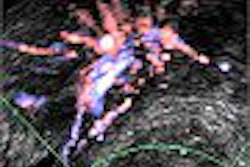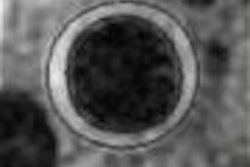Contrast-enhanced ultrasound (CEUS) can be an effective way to characterize focal liver lesions (FLL), and may offer potential cost-savings, according to two separate European studies.
The study researchers also found that CEUS was comparable to CT and MRI in diagnostic accuracy, and that it can reduce the need for further testing, depending on the experience and specialty of the reader.
"CT and MRI are often needed as second-line modalities for characterizing FLLs detected by ultrasound, thanks to information provided by contrast enhancement. Now similar information can be provided by CEUS," said Dr. Luigi Solbiati from the department of radiology at General Hospital in Busto Arsizio, Italy.
In the second study, Dr. Edward Leen from the University of Glasgow in Scotland and colleagues assessed the impact of CEUS in characterizing FLL. With their multicentre study, they found a reduced need for additional imaging tests following CEUS, as compared to following unenhanced ultrasound.
CEUS versus CT and MRI
The accuracy of CEUS equals that of CT and MRI with complete agreement in 96% of cases, Sobiati and colleagues found in a single-center study involving 686 patients. The group studied 694 FLLs with CEUS and CT or MRI, and compared the results.
CEUS with a bolus injection of SonoVue (Bracco, Milan, Italy) was done immediately after ultrasound. In addition, triphasic contrast-enhanced CT or MRI was done within 30 days, in 74% of the cases. In the rest of the cases, CEUS was done following contrast-enhanced helical CT or MRI within 30 days of sonography.
In 94.5% of FLL cases, the diagnosis from US/CEUS and CT/MRI were concordant, the group reported. "There was a high level of concordance for hepatocellular carcinoma (HCC) and hemangioma," Sobiati said in a presentation at the 2004 RSNA meeting in Chicago.
US/CEUS and CT/MRI were concordant in following cases:
 |
||
| No. of cases | FLL characterization | Percentage |
 |
||
| 262/276 | HCC | 95.3 |
| 3/6 | Cholangiocarcinoma | 50 |
| 204/214 | Metastasis | 95.3 |
| 162/167 | Hemangioma | 97 |
| 10/11 | FNH | 90.1 |
| 4/4 | Adenoma | 100 |
| 3/3 | Biliary cyst | 100 |
| 8/13 | Pseudolesion | 61.5 |
 |
||
Among the discordant findings, there was nearly equal percentage of benign and malignant lesions at 5.6% and 5.4%, respectively. With discordant diagnoses, fine-needle aspiration biopsy (FNAB) was performed to confirm the findings. FNAB confirmed CT or MRI diagnosis in 3.5% of the cases and CEUS diagnosis in 2% of the cases.
Overall, the accuracy of CEUS for characterization was 96.5% (191 of 198) accurate for benign lesions, and 96.6% (479 of 496) accurate for malignant lesions. Accuracy was 96.1% in the 515 cases in which CEUS was performed immediately after noncontrast ultrasound, Solbiati said.
CEUS performed as the second phase of the ultrasound examination was accurate enough to avoid CT or MRI in most cases, the group concluded. "CEUS can be integrated with diagnostic algorithms of FLL with significant decrease in cost-diagnosis ratio," the researchers stated.
The group's findings concur with other studies on FLL characterization with contrast-enhanced ultrasound. Another group from Italy used a sulfur hexafluoride-filled microbubble contrast agent, and reported improved diagnostic performance and improved characterization of solid FLL (Radiology, August 2004, Vol. 232:2, pp. 420- 430).
Solbiati also pointed out that CEUS can be the first diagnostic assessment performed along with noncontrast sonography, "permitting a one-step diagnosis and avoiding ... more expensive or invasive diagnostic procedures."
Fewer tests, more savings
For the second study, Leen and colleagues focused on the potential cost-savings associated with CEUS. Specifically, their study looked at how reader speciality and experience would impact the characterization of atypical FLL on CEUS.
"The results suggest that CEUS improves the characterization of FFL, limiting the need for further tests, with potential cost-savings depending on the experience and speciality of the reader," the researchers stated in another RSNA presentation.
For this study, two readers -- a gastroenterologist with 12 months of experience with CEUS and a radiologist with four months of experience -- reviewed digital vide tapes of US and CEUS in a random sequence.
The tapes consisted of nonlinear, fundamental B-mode, and power Doppler imaging performed at baseline, as well as nonlinear imaging of the hepatic lesion in arterial, portal, and late phases after SonoVue administration. The patient population consisted of 124 patients with 135 atypical FLLs.
The baseline US and CEUS diagnoses were compared. For both readers CEUS showed a decrease in indeterminate diagnosis and an increase in accurate diagnosis. For benign lesions the two readers' accuracy of diagnosis increased by 88% and 55%, and for malignant lesions 32% and 48%. The standard of reference was biopsy, or CT or MR combined, and consensus reading of all exams by the two readers.
"Overall concordance with the standard of reference ranged between 93.3% and 94.8% following CEUS, compared with between 41.8% and 42.5% on US for both readers," the group wrote in their RSNA abstract.
There was close co-relation of the results for both readers, and the accuracy of diagnosis for US and CEUS in different cases (for one reader) was as follows:
 |
||
| FLL | Accuracy of diagnosis following CEUS (%) | Accuracy of diagnosis following US (%) |
 |
||
| Metastases | 100 | 50 |
| HCC | 87.7 | 42.7 |
| FNH | 84.6 | 0 |
| Hemangioma | 91.7 | 16.7 |
 |
||
Indeterminate diagnosis for the two readers reduced by 51% and 56%, and need for additional imaging tests reduced by 90.4% and 23.7% following CEUS, the researchers reported.
By N. Shivapriya
AuntMinnie.com contributing writer
March 25, 2005
Related Reading
Breath-hold technique comparable to respiratory-triggered MR for liver imaging, March 16, 2005
Exam technique critical in liver ultrasound, October 22, 2004
Copyright © 2005 AuntMinnie.com



















